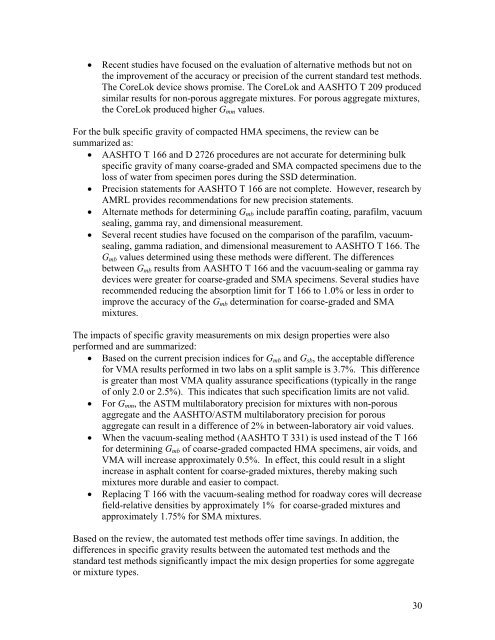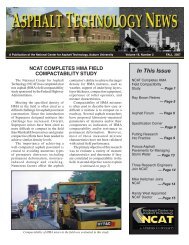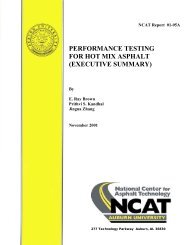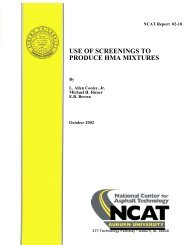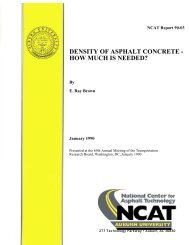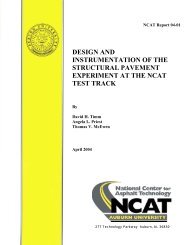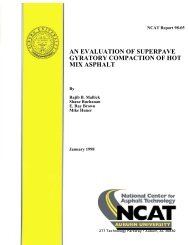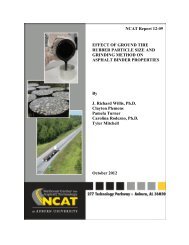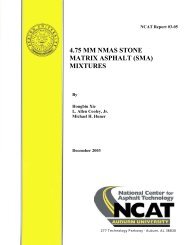A Review of Aggregate and Asphalt Mixture Specific Gravity ...
A Review of Aggregate and Asphalt Mixture Specific Gravity ...
A Review of Aggregate and Asphalt Mixture Specific Gravity ...
You also want an ePaper? Increase the reach of your titles
YUMPU automatically turns print PDFs into web optimized ePapers that Google loves.
Recent studies have focused on the evaluation <strong>of</strong> alternative methods but not onthe improvement <strong>of</strong> the accuracy or precision <strong>of</strong> the current st<strong>and</strong>ard test methods.The CoreLok device shows promise. The CoreLok <strong>and</strong> AASHTO T 209 producedsimilar results for non-porous aggregate mixtures. For porous aggregate mixtures,the CoreLok produced higher G mm values.For the bulk specific gravity <strong>of</strong> compacted HMA specimens, the review can besummarized as: AASHTO T 166 <strong>and</strong> D 2726 procedures are not accurate for determining bulkspecific gravity <strong>of</strong> many coarse-graded <strong>and</strong> SMA compacted specimens due to theloss <strong>of</strong> water from specimen pores during the SSD determination. Precision statements for AASHTO T 166 are not complete. However, research byAMRL provides recommendations for new precision statements. Alternate methods for determining G mb include paraffin coating, parafilm, vacuumsealing, gamma ray, <strong>and</strong> dimensional measurement. Several recent studies have focused on the comparison <strong>of</strong> the parafilm, vacuumsealing,gamma radiation, <strong>and</strong> dimensional measurement to AASHTO T 166. TheG mb values determined using these methods were different. The differencesbetween G mb results from AASHTO T 166 <strong>and</strong> the vacuum-sealing or gamma raydevices were greater for coarse-graded <strong>and</strong> SMA specimens. Several studies haverecommended reducing the absorption limit for T 166 to 1.0% or less in order toimprove the accuracy <strong>of</strong> the G mb determination for coarse-graded <strong>and</strong> SMAmixtures.The impacts <strong>of</strong> specific gravity measurements on mix design properties were alsoperformed <strong>and</strong> are summarized: Based on the current precision indices for G mb <strong>and</strong> G sb , the acceptable differencefor VMA results performed in two labs on a split sample is 3.7%. This differenceis greater than most VMA quality assurance specifications (typically in the range<strong>of</strong> only 2.0 or 2.5%). This indicates that such specification limits are not valid. For G mm , the ASTM multilaboratory precision for mixtures with non-porousaggregate <strong>and</strong> the AASHTO/ASTM multilaboratory precision for porousaggregate can result in a difference <strong>of</strong> 2% in between-laboratory air void values. When the vacuum-sealing method (AASHTO T 331) is used instead <strong>of</strong> the T 166for determining G mb <strong>of</strong> coarse-graded compacted HMA specimens, air voids, <strong>and</strong>VMA will increase approximately 0.5%. In effect, this could result in a slightincrease in asphalt content for coarse-graded mixtures, thereby making suchmixtures more durable <strong>and</strong> easier to compact. Replacing T 166 with the vacuum-sealing method for roadway cores will decreasefield-relative densities by approximately 1% for coarse-graded mixtures <strong>and</strong>approximately 1.75% for SMA mixtures.Based on the review, the automated test methods <strong>of</strong>fer time savings. In addition, thedifferences in specific gravity results between the automated test methods <strong>and</strong> thest<strong>and</strong>ard test methods significantly impact the mix design properties for some aggregateor mixture types.30


